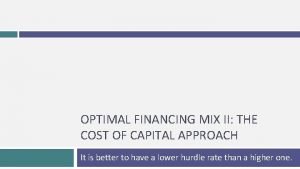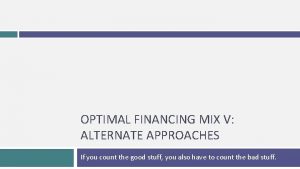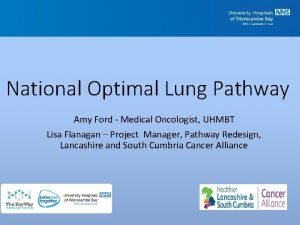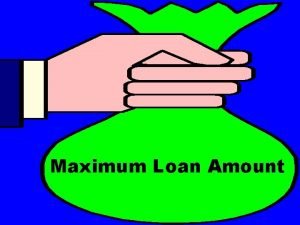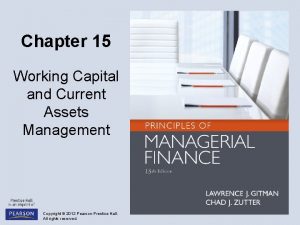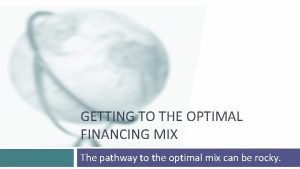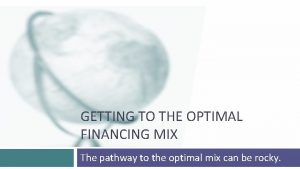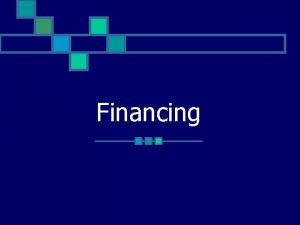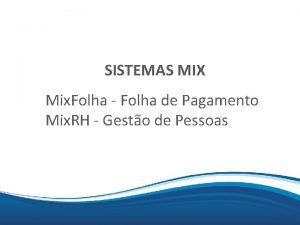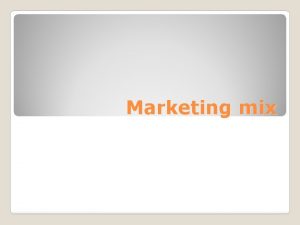GETTING TO THE OPTIMAL FINANCING MIX The pathway







- Slides: 7

GETTING TO THE OPTIMAL FINANCING MIX The pathway to the optimal mix can be rocky.


Now that we have an optimal. . And an actual. . What next? At the end of the analysis of financing mix (using whatever tool or tools you choose to use), you can come to one of three conclusions: The firm has the right financing mix It has too little debt (it is under levered) It has too much debt (it is over levered) The next step in the process is Deciding how much quickly or gradually the firm should move to its optimal Assuming that it does, how should it move to its optimal, i. e. , a recapitalization or investments. 3

A Framework for Getting to the Optimal Is the actual debt ratio greater than or lesser than the optimal debt ratio? Actual > Optimal Overlevered Actual < Optimal Underlevered Is the firm under bankruptcy threat? Yes No Reduce Debt quickly 1. Equity for Debt swap 2. Sell Assets; use cash to pay off debt 3. Renegotiate with lenders Does the firm have good projects? ROE > Cost of Equity ROC > Cost of Capital Yes No Take good projects with 1. Pay off debt with retained new equity or with retained earnings. 2. Reduce or eliminate dividends. 3. Issue new equity and pay off debt. Is the firm a takeover target? Yes Increase leverage quickly 1. Debt/Equity swaps 2. Borrow money& buy shares. No Does the firm have good projects? ROE > Cost of Equity ROC > Cost of Capital Yes Take good projects with debt. No Do your stockholders like dividends? Yes Pay Dividends No Buy back stock 4

Disney: Applying the Framework Is the actual debt ratio greater than or lesser than the optimal debt ratio? Actual > Optimal Overlevered Actual < Optimal Actual (11. 5%) < Optimal (40%) Is the firm under bankruptcy threat? Yes No Reduce Debt quickly 1. Equity for Debt swap 2. Sell Assets; use cash to pay off debt 3. Renegotiate with lenders Does the firm have good projects? ROE > Cost of Equity ROC > Cost of Capital Yes No Take good projects with 1. Pay off debt with retained new equity or with retained earnings. 2. Reduce or eliminate dividends. 3. Issue new equity and pay off debt. Is the firm a takeover target? Yes Increase leverage quickly 1. Debt/Equity swaps 2. Borrow money& buy shares. No. Large mkt cap & positive Jensen’s a Does the firm have good projects? ROE > Cost of Equity ROC > Cost of Capital Yes. ROC > Cost of capital Take good projects With debt. No Do your stockholders like dividends? Yes Pay Dividends No Buy back stock 5

6 Application Test: Getting to the Optimal Based upon your analysis of both the firm’s capital structure and investment record, what path would you map out for the firm? a. b. c. Immediate change in leverage Gradual change in leverage No change in leverage Would you recommend that the firm change its financing mix by a. b. Paying off debt/Buying back equity Take projects with equity/debt 6

Task If your firm’s actual debt ratio is different from its optimal, evaluate how quickly it has to act & what the best course of action is. 7 Read Chapter 9
